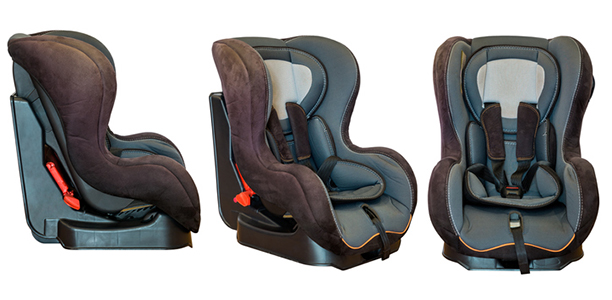Many different types of car restraints are available. Different types are suitable for use by babies and children up to 10 years of age. In Australia, car restraints are grouped into four distinct types, as well as combination types. Using a restraint which is appropriate for a child’s age and size is a legal requirement in Australia.
Rear facing restraints (baby capsules)
 Rear facing restraints, commonly referred to as baby capsules, are devices in which babies lie facing the rear of the car when travelling. They are the correct type of restraint for all babies under six months of age. Older babies should continue to travel in a rear facing restraint as long as their size permits, then progress to a forward facing car seat with a harness.
Rear facing restraints, commonly referred to as baby capsules, are devices in which babies lie facing the rear of the car when travelling. They are the correct type of restraint for all babies under six months of age. Older babies should continue to travel in a rear facing restraint as long as their size permits, then progress to a forward facing car seat with a harness.
A rear facing restraint is held in place with a tether strap at the top and a seat belt at the bottom. The tether strap is attached to the front of the restraint and to an anchor point in the car. When installing the restraint, you may need to check your vehicle owner’s guide to locate the anchor point.
Some rear facing child restraints are combination designs. They can be converted to forward facing chair restraints as the baby grows older.
Rear facing restraints should never be positioned in the front seat of a car with an airbag as it is very dangerous. All children under four are required to sit in the back seat, if your car has at least two rows of seats. As such, it is illegal to put an infant restraint in the front seat if your car has more than one row of seats.
Forward facing restraints with built-in harness
 A forward facing car seat with harness restraint is suitable for a young child who has outgrown a rear facing restraint, but is too small for a booster seat. Babies over six months who no longer fit in a rear facing baby capsule and children under four years of age must travel in a forward facing seat with a built-in harness. Children who grow quickly and are too big for the car seat before they reach four years of age can move on to a booster seat.
A forward facing car seat with harness restraint is suitable for a young child who has outgrown a rear facing restraint, but is too small for a booster seat. Babies over six months who no longer fit in a rear facing baby capsule and children under four years of age must travel in a forward facing seat with a built-in harness. Children who grow quickly and are too big for the car seat before they reach four years of age can move on to a booster seat.
The forward facing restraint should have a six-point inbuilt harness system. As a minimum, it must be a five-point harness. A six-point harness consists of two straps running from the top of the seat over the child’s shoulders, to secure their torso and prevent their head jolting; two straps across the hips; and two straps at the centre bottom of the restraint, on either side of the child’s groin, to secure their lower body in the restraint. A five-point harness has only one strap at the groin. The harness should buckle together at a central point around the child’s tummy.
If there are no back seats available (i.e. younger children in restraints are already using these places), a forward facing restraints may be used in the front seat of a car. However, the seat must be moved as far away as possible from the airbag (i.e. pushed as far back as possible) to avoid the possibility of suffocation should the airbag be deployed.
Booster seats and cushions
 Booster seats and cushions are designed to boost a child’s height so that they are high enough to be properly restrained by a lap-sash belt (a seat belt which fits across the lap and shoulder). They are suitable for children 4 years of age and older who do not fit in a forward facing restraint and who are less than 145 cm tall.
Booster seats and cushions are designed to boost a child’s height so that they are high enough to be properly restrained by a lap-sash belt (a seat belt which fits across the lap and shoulder). They are suitable for children 4 years of age and older who do not fit in a forward facing restraint and who are less than 145 cm tall.
Booster seats have a back, whereas booster cushions have only a seating plane which fits against the seat back of the car. Booster cushions are legal but not recommended; they will not protect a child in a side-impact crash. Booster cushions are no longer being manufactured in Australia.
Booster seats are used in conjunction with the car’s fitted lap-sash seatbelt. If they are placed in the middle seat of an older model car which has a lap-only belt, they should be used in conjunction with a forward-facing harness.
Forward facing harness without a seat
A forward-facing harness (also called an H-harness) is a harness which restrains both shoulders and connects to a lap belt fitted in the car. In general, forward facing harnesses without a child seat are not recommended. It is not safer than using a lap-sash seatbelt and can increase the risk of injury. A forward facing harness should only be considered as a last resort, in vehicles with lap-only belts and in conjunction with a booster seat designed for use with a forward facing harness.
When does my child no longer need a restraint or booster seat?
In Australia, children who are under the age of seven are required by law to be restrained by either a forward facing restraint with a built-in harness or a booster seat when they are travelling in a car. Children who are seven years or older are not required by law to use a restraint or booster seat. However, it is strongly recommended that they continue using a restraint or booster seat until they are at least 145 cm tall. This recommendation is based on evidence that children who use an adult seatbelt without a booster seat when they are not tall enough are at a much greater risk of seatbelt syndrome (serious injury to the lower back or abdomen).
Use the five-step test below to see if your child still requires a booster seat:
- Step 1: Your child should be able to sit all of the way back in the seat;
- Step 2: Your child’s knees should comfortably bend over the edge of the seat;
- Step 3: The sash belt should be positioned across the middle of their shoulder;
- Step 4: The lap belt should sit firmly across their thighs; and
- Step 5: Your child should be able to sit in this position for the whole car journey.
If your child can do all of the above, they may no longer require a booster seat.

References
- Product Safety Australia. Child car restraints for use in motor vehicles [online]. 2017 (cited 24 May 2017). Available from: URL Link
- Queensland Government. Child restraints [online]. 2015 (cited 30 July 2015). Available from: URL Link
- Government of Western Australia. Child car restraints [online]. 2015 (cited 24 May 2017). Available from: URL Link
- Kidsafe NSW Inc. Child restraints frequently asked questions [online]. 2012 (cited 24 May 2017). Available from: URL Link
- Neuroscience Research Australian and Kidsafe. Best practice guideline for the safe restraint of children travelling in motor vehicles [online]. 2013 (cited 13 August 2015). Available from: URL Link
- New South Wales Government. Child car seats [online]. 2015 (cited 30 July 2015). Available from: URL Link
- Australian Government. Safety standard: Child restraint systems for use in motor vehicles [online]. 2014 (cited 30 July 2015). Available from: URL Link
- Vic Roads. Frequently asked questions about child restraints [online]. 2015 (cited 30 July 2015). Available from: URL Link











